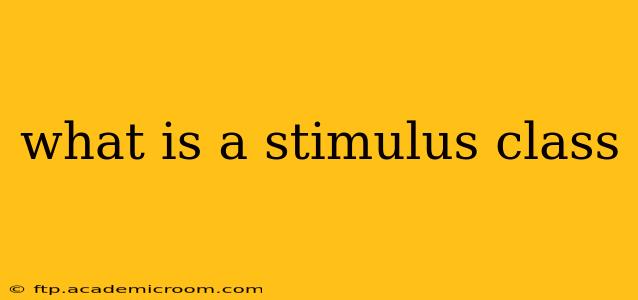What is a Stimulus Class?
In the field of applied behavior analysis (ABA), a stimulus class refers to a group of stimuli that share a common characteristic and evoke the same operant response. These stimuli might look different, sound different, or even feel different, but they all elicit a similar reaction from an individual because of their shared properties. Understanding stimulus classes is crucial for effective teaching and behavior modification.
This concept is fundamental because it allows us to generalize learning. Instead of teaching a response to only one specific stimulus, we can teach to a whole class of stimuli, leading to more adaptable and functional behavior.
What are the different types of stimulus classes?
There are three main types of stimulus classes:
1. Formal Stimulus Classes: These are defined by their physical features. Stimuli in a formal class share commonalities in their observable characteristics. For example, a formal stimulus class might include all red objects, all large squares, or all sounds above 100 decibels. The unifying feature is a directly observable property.
2. Functional Stimulus Classes: These are defined by the effect the stimuli have on behavior. Stimuli in a functional class evoke the same response, even though they may not share any obvious physical properties. For example, a functional stimulus class might consist of a bell ringing, a teacher clapping their hands, and a verbal cue to "clean up" - all of which trigger the same response of tidying up a classroom. The shared property here is the function each stimulus plays in eliciting a specific behavior.
3. Temporal Stimulus Classes: These are defined by their temporal location relative to a behavior or other stimuli. They function to signal the likelihood of future events. For example, a red light at a traffic intersection signals a potential consequence (stopping), while the smell of freshly baked cookies might signal the upcoming opportunity to eat (antecedent stimulus). These stimuli don't share visual or auditory characteristics, but they share a relationship with the subsequent event.
How are stimulus classes formed?
Stimulus classes are formed through the process of stimulus generalization. This occurs when a learned response to one stimulus is evoked by similar stimuli. The more similar the new stimulus is to the original, the more likely generalization will occur. This is why teaching to a class of stimuli, rather than individual examples, is so effective for promoting enduring behavior changes.
What are some examples of stimulus classes in everyday life?
We encounter stimulus classes constantly in our daily lives, often without even realizing it. For instance:
- Identifying fruits: Apples, bananas, oranges—all different in appearance, yet all belong to the stimulus class "fruit" and might evoke a similar response like wanting to eat them.
- Understanding instructions: "Stop," "Halt," and "Freeze" are all different words, but they belong to a functional stimulus class indicating cessation of activity.
- Responding to different forms of money: A five-dollar bill, a ten-dollar bill, and a twenty-dollar bill all belong to the functional stimulus class of "money" and can evoke the same response—purchasing goods or services.
How are stimulus classes important in education?
In education, understanding stimulus classes is crucial for effective teaching. By teaching students to respond to a whole class of stimuli rather than individual instances, we can promote generalization and ensure that learning is both effective and enduring. For example, teaching a child to read sight words can be more effective by teaching them within a phonological class or a semantic class, making it easier for them to decode and understand new words independently.
What is the difference between stimulus control and stimulus generalization?
While related, stimulus control and stimulus generalization are distinct concepts. Stimulus control refers to the degree to which a stimulus reliably evokes a specific response. Stimulus generalization is the extent to which a response learned to one stimulus is evoked by similar stimuli. A strong stimulus control means the behavior happens reliably in the presence of the target stimulus, while generalization expands that control to related stimuli.
Understanding stimulus classes is vital for those working in ABA, education, and other fields that seek to change behavior effectively. By recognizing the different types of stimulus classes and how they are formed, we can create more robust and lasting learning experiences.
